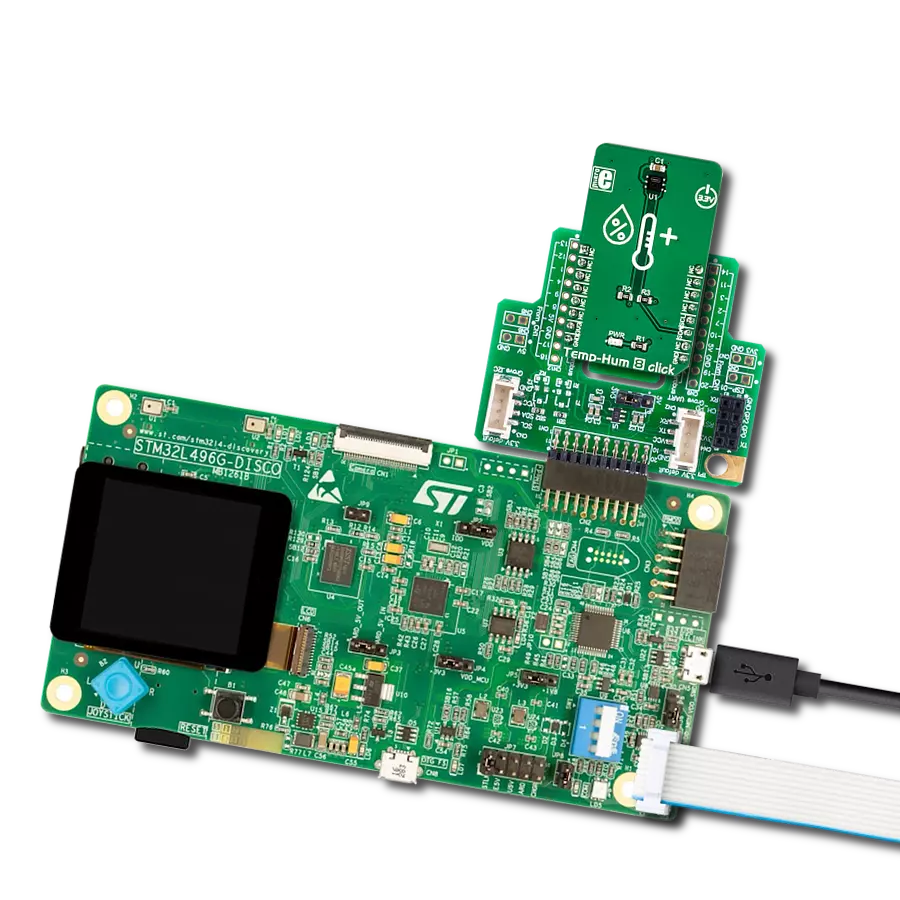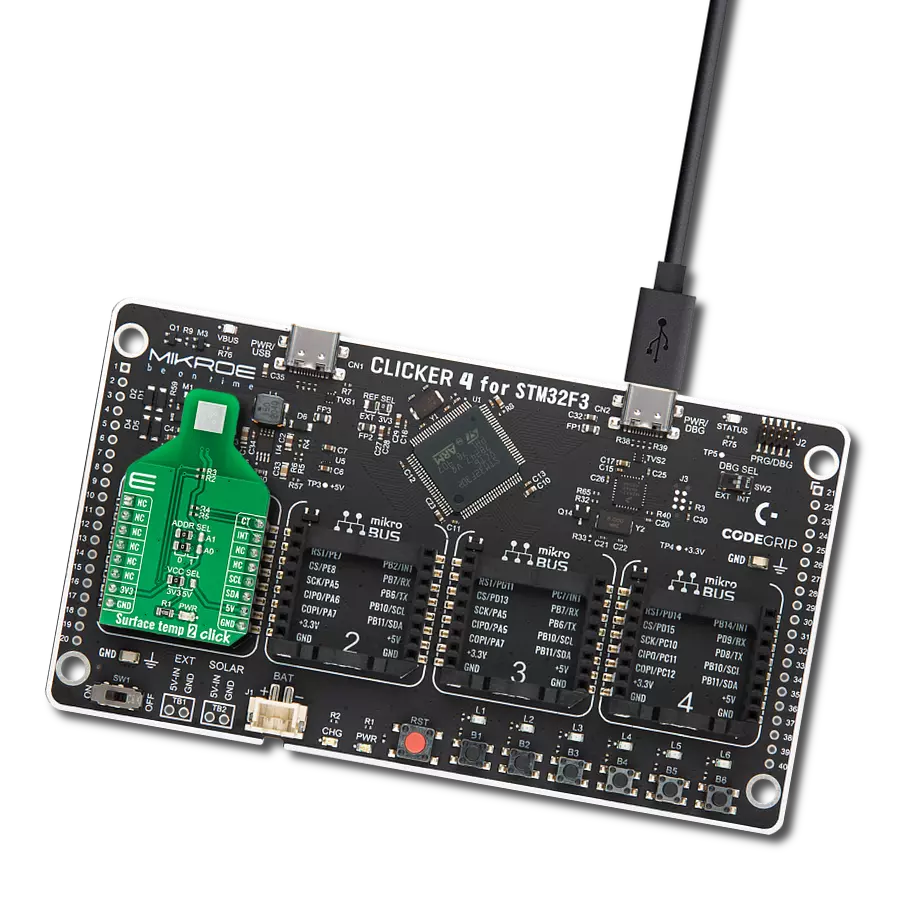Experience the power of contactless temperature monitoring for swift, accurate, and reliable results!
A
A
Hardware Overview
How does it work?
IrThermo 2 Click is based on the TMP007, an infrared thermopile sensor with an integrated Math Engine from Texas Instruments. When there is infrared radiation, and the sensor absorbs it, the integrated Math Engine calculates its temperature by comparing it with the temperature of the silicon die. The sensor is factory calibrated, but the user can adjust the calibration coefficients for specific applications. This adjustment could be the correction for the range, field of view, object shape, and environmental factors. Besides the direct
reading of the object temperature, Math Engine features programmable alerts, nonvolatile memory (EEPROM) for storing calibration coefficients, and transient correction. The IrThermo 2 Click uses an industry-standard I2C interface to communicate with the host MCU over the mikroBUS™ socket. One of eight programmable I2C addresses can be set over the ADR1 and ADR0 solder jumpers labeled ADDR SEL and positions 1 and 0. Those jumpers are set to 0 (GND) by default. It also features an active LOW
alert output on pin AL that can be used as an alert function if the TMP007 is working in an interrupt mode. This Click board™ can operate with either 3.3V or 5V logic voltage levels selected via an onboard jumper. This way, both 3.3V and 5V capable MCUs can use the communication lines properly. However, the Click board™ comes equipped with a library containing easy-to-use functions and an example code that can be used, as a reference, for further development.
Features overview
Development board
Arduino UNO is a versatile microcontroller board built around the ATmega328P chip. It offers extensive connectivity options for various projects, featuring 14 digital input/output pins, six of which are PWM-capable, along with six analog inputs. Its core components include a 16MHz ceramic resonator, a USB connection, a power jack, an
ICSP header, and a reset button, providing everything necessary to power and program the board. The Uno is ready to go, whether connected to a computer via USB or powered by an AC-to-DC adapter or battery. As the first USB Arduino board, it serves as the benchmark for the Arduino platform, with "Uno" symbolizing its status as the
first in a series. This name choice, meaning "one" in Italian, commemorates the launch of Arduino Software (IDE) 1.0. Initially introduced alongside version 1.0 of the Arduino Software (IDE), the Uno has since become the foundational model for subsequent Arduino releases, embodying the platform's evolution.
Microcontroller Overview
MCU Card / MCU

Architecture
AVR
MCU Memory (KB)
32
Silicon Vendor
Microchip
Pin count
28
RAM (Bytes)
2048
You complete me!
Accessories
Click Shield for Arduino UNO has two proprietary mikroBUS™ sockets, allowing all the Click board™ devices to be interfaced with the Arduino UNO board without effort. The Arduino Uno, a microcontroller board based on the ATmega328P, provides an affordable and flexible way for users to try out new concepts and build prototypes with the ATmega328P microcontroller from various combinations of performance, power consumption, and features. The Arduino Uno has 14 digital input/output pins (of which six can be used as PWM outputs), six analog inputs, a 16 MHz ceramic resonator (CSTCE16M0V53-R0), a USB connection, a power jack, an ICSP header, and reset button. Most of the ATmega328P microcontroller pins are brought to the IO pins on the left and right edge of the board, which are then connected to two existing mikroBUS™ sockets. This Click Shield also has several switches that perform functions such as selecting the logic levels of analog signals on mikroBUS™ sockets and selecting logic voltage levels of the mikroBUS™ sockets themselves. Besides, the user is offered the possibility of using any Click board™ with the help of existing bidirectional level-shifting voltage translators, regardless of whether the Click board™ operates at a 3.3V or 5V logic voltage level. Once you connect the Arduino UNO board with our Click Shield for Arduino UNO, you can access hundreds of Click boards™, working with 3.3V or 5V logic voltage levels.
Used MCU Pins
mikroBUS™ mapper
Take a closer look
Click board™ Schematic

Step by step
Project assembly
Track your results in real time
Application Output
1. Application Output - In Debug mode, the 'Application Output' window enables real-time data monitoring, offering direct insight into execution results. Ensure proper data display by configuring the environment correctly using the provided tutorial.

2. UART Terminal - Use the UART Terminal to monitor data transmission via a USB to UART converter, allowing direct communication between the Click board™ and your development system. Configure the baud rate and other serial settings according to your project's requirements to ensure proper functionality. For step-by-step setup instructions, refer to the provided tutorial.

3. Plot Output - The Plot feature offers a powerful way to visualize real-time sensor data, enabling trend analysis, debugging, and comparison of multiple data points. To set it up correctly, follow the provided tutorial, which includes a step-by-step example of using the Plot feature to display Click board™ readings. To use the Plot feature in your code, use the function: plot(*insert_graph_name*, variable_name);. This is a general format, and it is up to the user to replace 'insert_graph_name' with the actual graph name and 'variable_name' with the parameter to be displayed.

Software Support
Library Description
This library contains API for IrThermo 2 Click driver.
Key functions:
irthermo2_get_raw_temperature- Function read 16-bit data from raw temperature register and calculate temperature in degrees Celsiusirthermo2_get_object_temperature_c- Function read 16-bit data from object temperature register and calculate temperature in degrees Celsiusirthermo2_get_object_temperature_f- Function read 16-bit data from object temperature register and calculate temperature in degrees Fahrenheit
Open Source
Code example
The complete application code and a ready-to-use project are available through the NECTO Studio Package Manager for direct installation in the NECTO Studio. The application code can also be found on the MIKROE GitHub account.
/*!
* @file main.c
* @brief IrThermo2 Click example
*
* # Description
* IrThermo 2 is a non-contact temperature measurement Click. The sensor absorbs the infrared
* radiation emitted by the target object (withing the sensor’s field of view) and
* the integrated math engine calculates its temperature by comparing it with the temperature
* of the silicon die. The measurement range of the sensor is between –40°C to 125°C.
*
* The demo application is composed of two sections :
*
* ## Application Init
* Initialization driver enable's - I2C, set default configuration and start write log.
*
* ## Application Task
* This is a example which demonstrates the use of IrThermo 2 Click board.
* Measures the object temperature value from sensor and calculate temperature in degrees Celsius [ C ].
* Results are being sent to the USART Terminal where you can track their changes.
* All data logs on usb uart for aproximetly every 5 sec when the data value changes.
*
*
* @author MikroE Team
*
*/
#include "board.h"
#include "log.h"
#include "irthermo2.h"
static irthermo2_t irthermo2;
static log_t logger;
static float temperature;
void application_init ( void )
{
log_cfg_t log_cfg;
irthermo2_cfg_t cfg;
/**
* Logger initialization.
* Default baud rate: 115200
* Default log level: LOG_LEVEL_DEBUG
* @note If USB_UART_RX and USB_UART_TX
* are defined as HAL_PIN_NC, you will
* need to define them manually for log to work.
* See @b LOG_MAP_USB_UART macro definition for detailed explanation.
*/
LOG_MAP_USB_UART( log_cfg );
log_init( &logger, &log_cfg );
log_info( &logger, "---- Application Init ----" );
// Click initialization.
irthermo2_cfg_setup( &cfg );
IRTHERMO2_MAP_MIKROBUS( cfg, MIKROBUS_1 );
irthermo2_init( &irthermo2, &cfg );
irthermo2_default_cfg( &irthermo2 );
Delay_ms ( 100 );
log_info( &logger, "---- Application Task ----" );
}
void application_task ( void )
{
temperature = irthermo2_get_object_temperature_c( &irthermo2 );
log_printf( &logger, " Temperature : %.2f C\r\n", temperature );
log_printf( &logger, "---------------------------\r\n" );
Delay_ms ( 1000 );
}
int main ( void )
{
/* Do not remove this line or clock might not be set correctly. */
#ifdef PREINIT_SUPPORTED
preinit();
#endif
application_init( );
for ( ; ; )
{
application_task( );
}
return 0;
}
// ------------------------------------------------------------------------ END
Additional Support
Resources
Category:Temperature & humidity


































